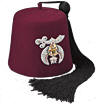
Shrine Protocol
The Fez:
The Imperial Council has adopted the fez as the exclusive type of head covering to be worn by all Nobles of the Mystic Shrine when appearing as such. This means all nobles must wear their fezzes at stated meetings, ceremonials, Shrine parades, caravans, special events and any other Shrine related activities. The fez is never worn at a Masonic Lodge communication or meeting.
As a Noble, you are particularly admonished never to wear your fez in any company or place in which you would decline to introduce your mother, wife, sister or daughter. Never forget this. No other person is ever allowed to wear a Noble’s fez.
The fez is not a display case or bulletin board. The Potentate, Divan Members, Past Potentates and the Grand Master may have their titles embroidered in small letters in gold or silver bullion, silk or rhinestone jewels on one line beneath the emblem on the fez. Active members of official uniformed units or official clubs of a temple may likewise have the names of their units or clubs on one line beneath the emblem on the fez. Any official appointment of the Potentate may have his title beneath the emblem as above for the term of his appointment.
The fez shall be worn in its proper shape without crushing, creasing or alteration; and no device, ornament, title, wording or adornment other than allowed by Article 13 of the Imperial Council shall be permitted. Not more than two pins or clasps, without supplemental embellishments, may be used to secure the tassel in place. The fez may be worn only at meetings and gatherings of Nobles held under the authority of some legal body of the Order. It may not be worn when or where prohibited by the Imperial Potentate. The fez as a general rule is not worn on Sunday, as the temple is not permitted to meet on that day. Hospital Day in Lexington is normally on a Sunday and you may were your fez while attending that function.
Military Salute:
The military salute is used when reciting the Shrine pledge of allegiance and during the playing of the national anthem of the United States of America, Canada, Mexico and Panama.
Colors:
A Noble who is wearing his fez will execute a right hand salute when the Colors are within six paces of him. He will not remove his fez. After the colors have passed, he should drop his right hand. A Noble who is not wearing his fez places his right hand over his heart instead of the right hand salute.
Auditorium:
In an auditorium, he should hold the salute until the Colors are posted after the pledge of allegiance and/or playing of the national anthems.
Parades:
Only the Color party of each temple is saluted when passing in review.
Meetings and Ceremonials:
Current dues card and password is required for admittance to all Temple Ceremonials and Business Meetings.
Prayer:
During the offering of prayer, the fez should be removed and held in the right hand over the heart.
The Salaam:
A Noble addressing the Potentate while he is presiding in the East should always give the salaam. The salaam is always given by the Potentate and members of his Divan when receiving the Imperial Potentate, Imperial Officers, and past Imperial Potentates do not salaam in return but give the sign of the order.
Salutations:
An Imperial Officer as well as a Past Imperial Potentate is always addressed as “Imperial Sir”. A Potentate or Past Potentate is addressed as “Illustrious Sir”.
Dress:
The proper attire for a Shriner at any given function is what fits the occasion. Under normal circumstances the Potentate will publicize the dress code.
Introduction of dignitaries:
The presiding officer of a Shrine Unit or Shrine Club should introduce the dignitaries that are there to visit them. There may be information that our Potentate needs to get out and it’s through these dignitaries the information is disseminated. At the beginning of your meeting you should determine who is present and you can check you calendar/directory as to who these people are. At the end of the meeting you should call upon each one in reverse order according to rank. Begin with Past Potentates, any Temple Trustees that are present, and then the Outer Guard or the lowest ranking officer present and ending with the Potentate or the highest ranking officer as the last speaker. No one should speak after the Potentate or the highest ranking officer with the exception of the presiding officer who will immediately close his meeting